Most Popular Types Of Kimono In Japan
When mentioning Japan, people will immediately think of the images of magnificent Fuji mountain, stunning cherry blossoms, romantic roads covered in red leaves, and of course Kimono – the traditional costume. Trying on Kimono is nearly a must for every tourist who comes to Japan. However, a variety of kimono types often cause struggle for visitors. If you are still wavering on what to wear, the introduction to types of kimono below will be of some help.
History of Japan’s Kimono
The word “kimono” comes from the verb ki, which means “to wear”, and the noun mono, which means “item”. To put it another way, kimono literally translates to “clothing”.
Kimonos were first made during the Heian period. As this practice became more popular, Japanese people began to notice how kimonos of different colors looked when worn together and that’s when the Japanese gained heightened color sensitivity. Thus, color combinations began to reflect seasonal hues or one’s political status. Warriors, for example, wore clothes whose colors represented their leaders.
During the Meiji Period, kimono went out of fashion as the Japanese government encouraged people to adopt Western clothing styles.
Nowadays, kimonos are rarely worn by Japanese people on a daily basis. They are only used for special occasions such as weddings, funerals, tea ceremonies, and other special events like Japanese festivals.
Most Popular Types Of Kimono In Japan
1. Furisode
In the Edo period, swinging large sleeves was a means of showing sentiment, so Furisode (Furi: swing, sode: sleeve) is the kimono style designed for unmarried women. Girls often wear Furisode on formal occasions such as wedding, tea ceremony or the coming of age ceremony. This kimono type is made of high-quality silks with bright colors. One special point of the design is the very long and large sleeves that cover the hands. Dependent on the length of sleeves, Furisode is categorized into 3 types: the Kofurisode with short sleeves, the Chu-furisode with medium sleeves and the Ofurisode where the sleeves almost reach the ground. In Japanese culture, that girls wear Furisode means they are ready to get married.
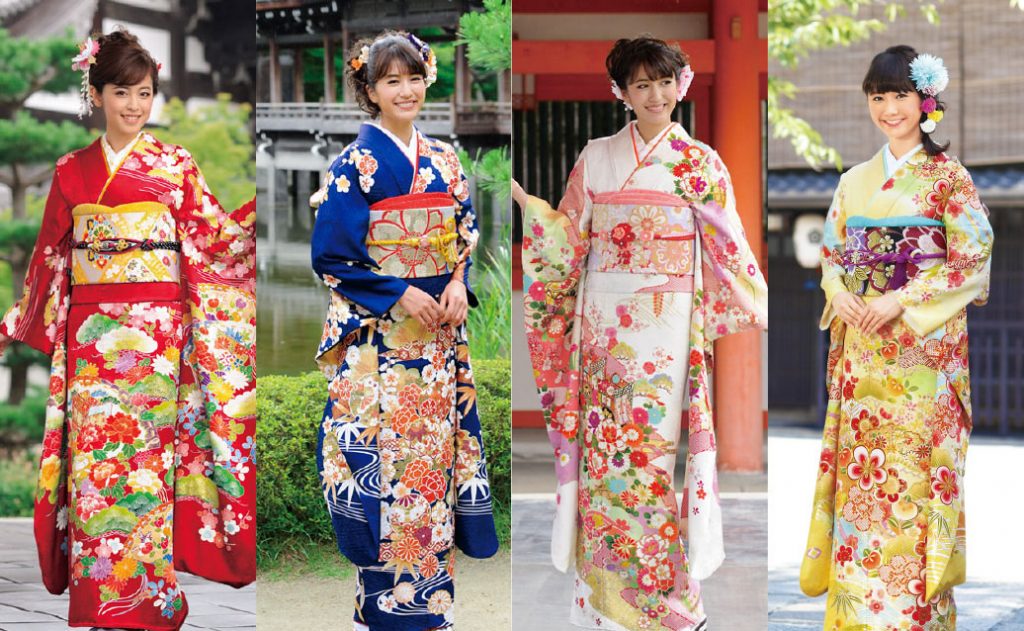
Wearing Furisode means a girl is mature and ready to get married
Gender expressed: Feminine, Unmarried
2. Tomesode
Unlike Furisode, Tomesode is the type of kimono for married women whether they divorced or not. This kimono style is specialized by short and narrow sleeves and simple-but-elegant patterns at the end of the lap. The traditional design is often black and embroidered family token on it. Women only wear Tomesode on the important occasion of family or relatives such as wedding.
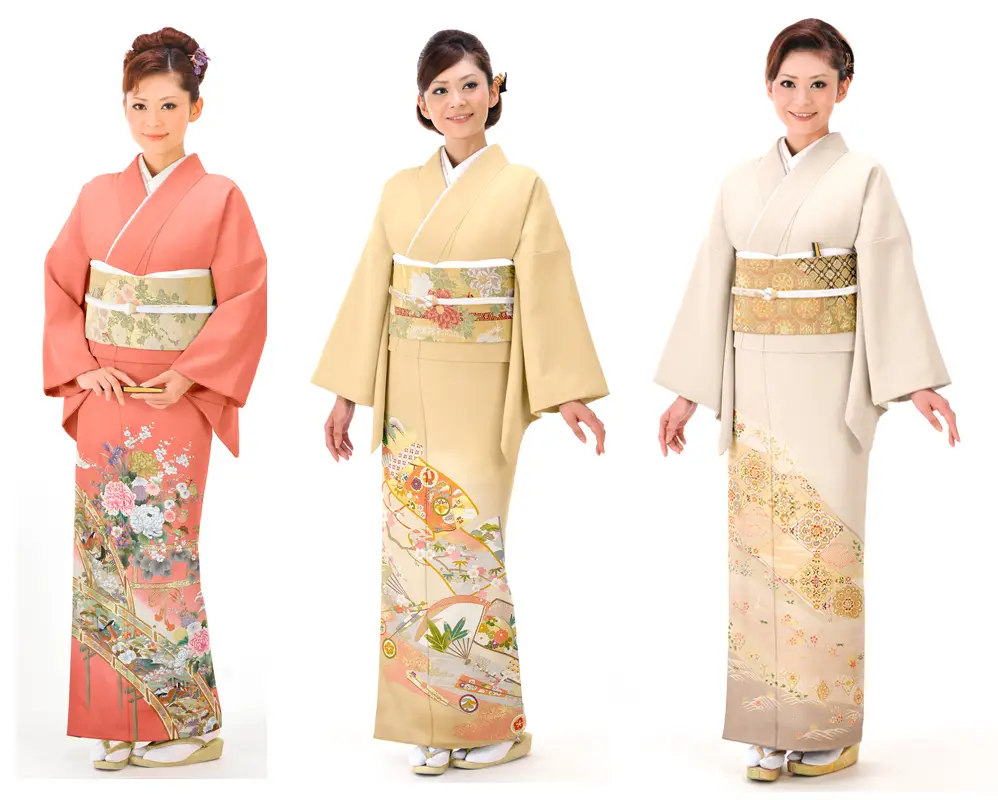
Women only wear Tomesode on the important occasion of family or relatives such as wedding.
SEE MORE:
Gender expressed: Feminine, Married
3. Houmongi
In Japanese, “houmon” means visiting. Houmongi is worn by women (often unmarried women) in formal occasions such as wedding ( often friends of the brides) and tea ceremony or other formal parties. The kimono body is in plain color with the same patterns in the shoulders, sleeves and lower lap of kimono. Japanese parents often buy houmongi as a gift for their daughters before they get married.

Houmongi has same patterns in the shoulders, sleeves and lower lap of kimono
Gender expressed: Feminine
4. Tsukesage
Tsukesage is the type of kimono that is worn on tea ceremonies, flower arrangement meetings and friend’s wedding. The design of Tsukesage bears a huge resemblance to that of Houmongi The difference is that the patterns of Tsukesage are more modest and cover a smaller area than Houmongi’s.

Different from Houmongi, patterns in the lower lap of Tsukesage just cover a smaller area
Gender expressed: Feminine, Married
5. Iromuji
Iromuji (色 無 地), which means “plain color”, is probably the easiest type of kimono to wear, although it may be less mentioned in kimono introductions. As its name suggests, it has only one color, no other patterns except submerged woven pattern on the fabric if sewn from rinzu, so it is less popular than other patterned and colorful kimonos. Iromuji can have any color, except black and white. This kimono type can be worn by both married and unmarried women, and the older women are, the more elegant colors will be preferred. Iromuji may not have a crest, or have a 1 or 3 or 5 crests. The presence of crests raises the formality of kimono.

Iromuji is plain and single-colored
Gender expressed: Feminine
6. Komon
Komon, which literally means small pattern, has repeated patterns throughout the garment. This kimono style is more casual and may be worn around town. The fabric is very diverse, ranging from silk, wool, polyester to rayon. This was the most common dress in Japan before Western clothes became popular in Japan.
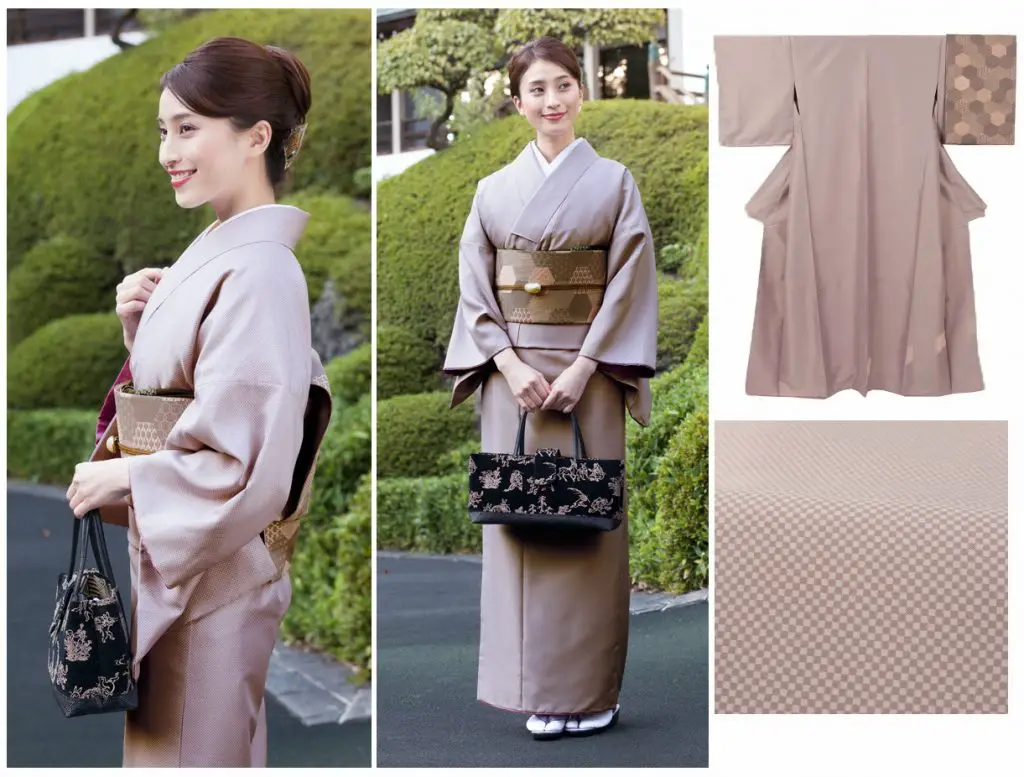
The same patterns stretch out on Komon in every direction
Gender expressed: Masculine and Feminine
7. Mofuku
This type of kimono is solid black, and all the accessories are also in black. Mofuku is formal mourning dress for men or women. The completely black mourning ensemble is usually reserved for family and others who are close to the deceased.
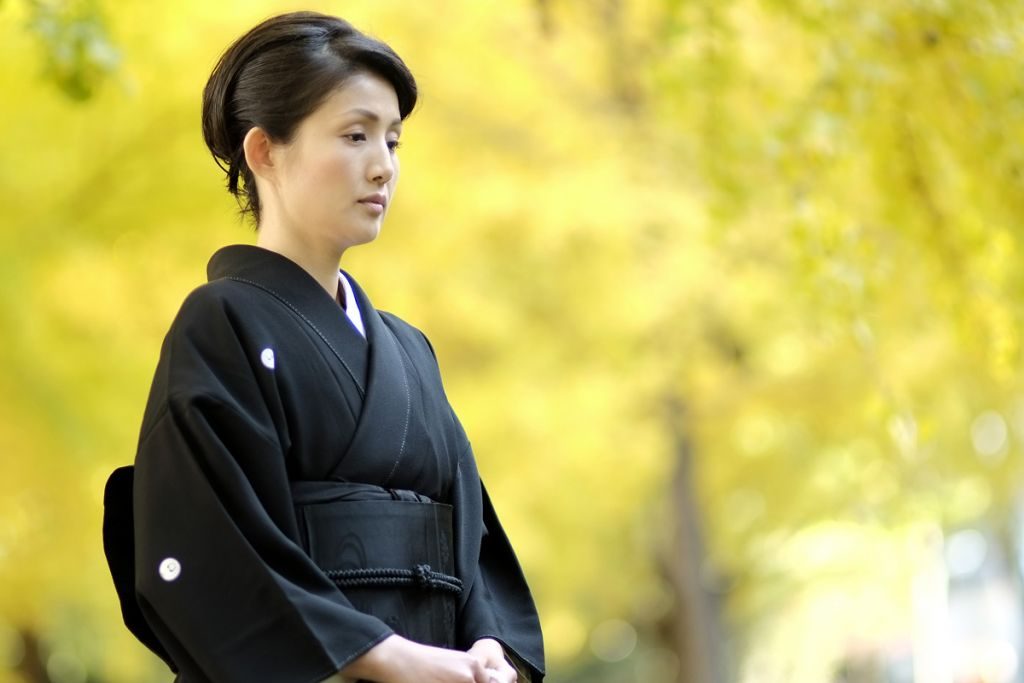
Covered in solid black, Mokuku is mourning attire
Gender expressed: Masculine and Feminine
8. Uchikake
Uchikake is a very formal kimono worn by brides or stage performers. It is worn outside the actual kimono, so it is never tied with an obi. The Uchikake design (mainly bridal costume) use red or white as the base colors. This dress is longer than other types of kimono, often trails the floor.
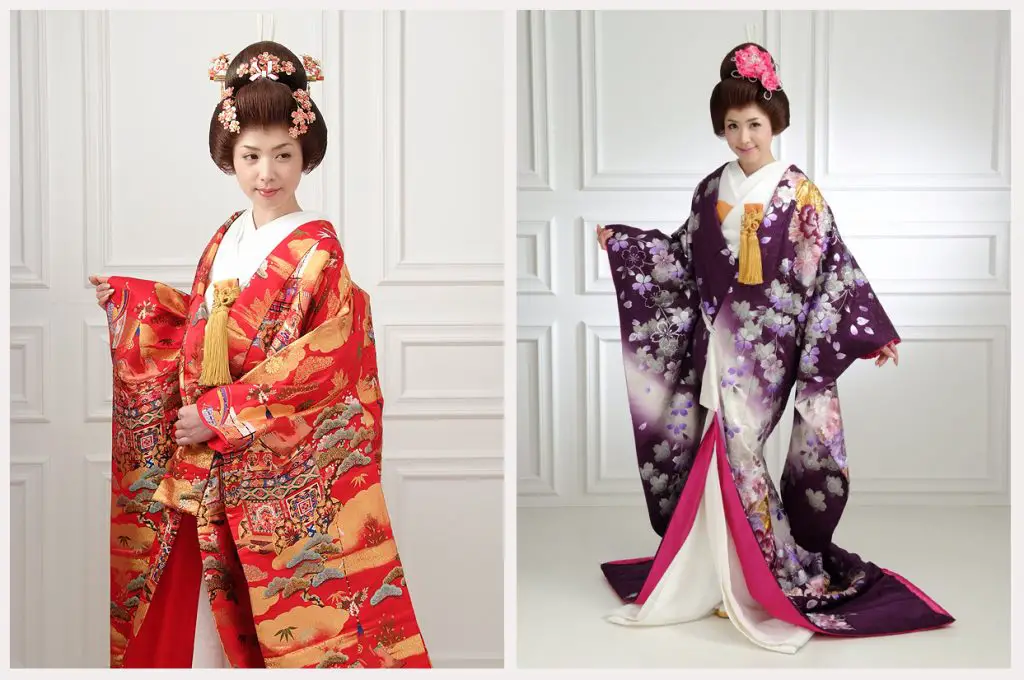
With red or white as the base colors, Uchikake is a very formal kimono worn by brides or stage performers
Gender expressed: Feminine
9. Shiromuku
This type of Kimono is the most complicated and worn in the traditional wedding. The dress is very long and trails the floor in the circle, so the brides need others’ assistance to walk steadily. In contrast to Mofuku, Shiromuku and all the accessories including a headdress called tsunokakushi and chonmage (a kind of traditional topknot) are all in white – the color of purity and maidenhood of the bride coming into the marriage.

Shiromuku is the most complicated and worn by women in the traditional wedding
Gender expressed: Feminine, Married
10. Susohiki/ Hikizuri
The susohiki is usually worn by geisha or by stage performers of the traditional Japanese dance. Like Shiromuku, the dress is very long, up to 2m (about 6.6 ft), and trails the floor. However, the design of Susohiki is different from others’. Normally, the kimono collar is a fist-size down from the nape of the neck, but Susohiki’s is even lower than this. In order not to show the pulled-down collar, the seam between the shoulders and sleeves are longer in the front than in the back.
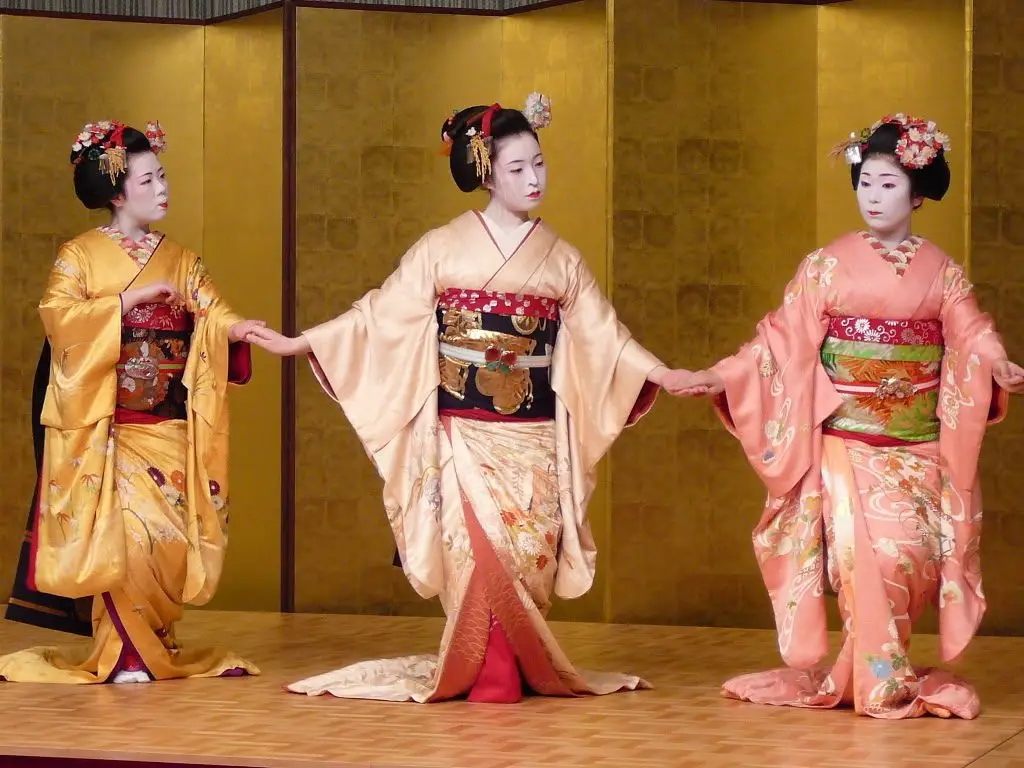
Susohiki is the costume of geisha and stage performers
Gender expressed: Feminine
11. Juunihitoe
Juunihitoe is an extremely elegant and highly complex type of kimono that was only worn by Japanese court-ladies. The Juunihitoe consist of various layers which are silk garments, with the innermost garment being made of white silk. This kimonotype is among the most expensive Japanese clothings. Today, Juunihitoe can only be seen in movies, museums, festivals or in some important events of the Imperial Household.
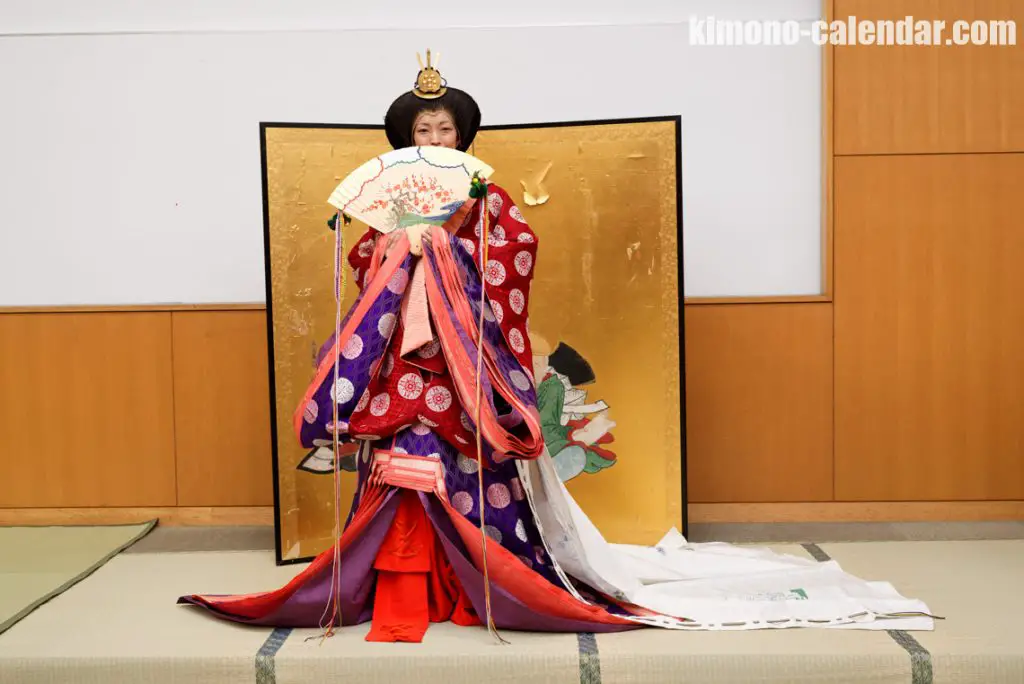
Juunihitoe is an extremely elegant and highly complex kimono that was only worn by Japanese court-ladies
Gender expressed: Feminine
12. Yukata
Last but not least, Yukata may be the most well-known type of kimono to foreigners. It is a type of kimono made of ordinary cotton, used in summer. Compared to Furisode, Yukata are much simpler. As a result, Japanese women know how to wear it without help just after learning for several times. In the past, the traditional Yukata usually had only two sets of colors: white – black or blue – white, but in the last few years this kimono style has been designed in many eye-catching colors. In ancient times, Yukata was only used at home as bathing wear, but today, Yukata is often worn by both men and women on Bon-Odori day (Japanese traditional dance festival in summer) and other summer festivals. Moreover, tourists can also see Yukata in traditional Japanese inns.
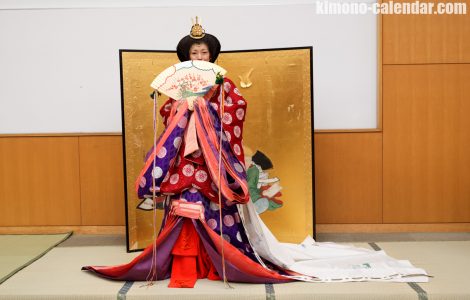
Yukata is colorful summer kimono
Gender expressed: Masculine and Feminine.
13. Odori Katamigawari
Odori is a Japanese word that means “dancing”, so Odori Katamigawari is a kimono worn by a traditional Japanese dancer. Tsukesage, houmongi or komon are different odori kimono styles.They’re usually made of synthetic fabrics, which can be washed more frequently than silk, and they’re usually unlined or only lightly lined to keep the dancer cool.
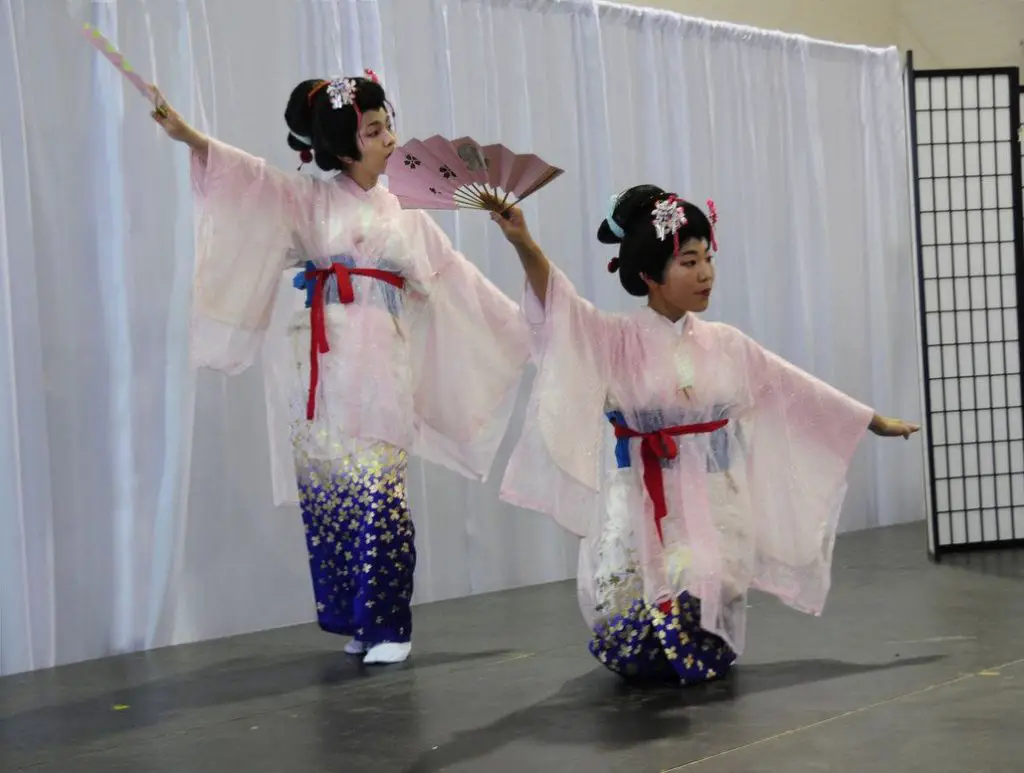
Odori Katamigawari is a kimono worn by a traditional Japanese dancer.
Gender Expressed: Masculine & Feminine
14. Onsen Kimono
Onsen kimonos are the most informal types of kimono in Japan. When visiting Japan, you may see these kimono styles at the bathhouses, hot springs, and in other lounge settings. These kimonos are basically bathrobes.
Because onsen kimonos are subject to water exposure, they are made of a soft, easy-to-care-for cotton, making washing and caring for them a breeze. These types of kimonos are best for relaxing around the house and should not be worn out in public. Onsen kimonos are excellent gifts for anyone looking for a high-quality robe for personal usage.
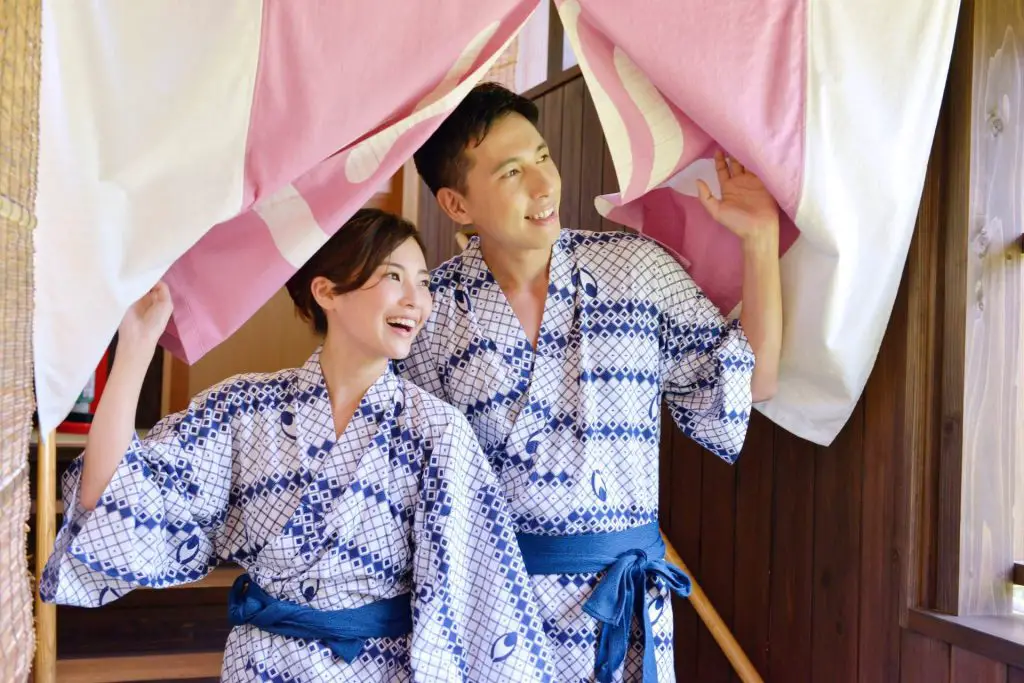
Onsen kimonos are the most informal types of kimono in Japan. You may encounter them at the bathhouses, hot springs, and in other lounge settings.
Gender Expressed: Masculine & Feminine
Frequently Asked Questions
1. Are There Any Types Of Kimono For Men?
Yes, there are also types of kimono for men. You know, men used to wear kimonos every day, but now this practice has become less common. In comparison with women’s kimonos, men’s kimonos are simpler with basic colors.
A combination of hakama (kimono pants) and Haori (kimono jacket) is the most formal men’s kimono style. Kinagashi, which is simply worn with an obi belt knotted around the waist, is the most popular men’s kimono type.
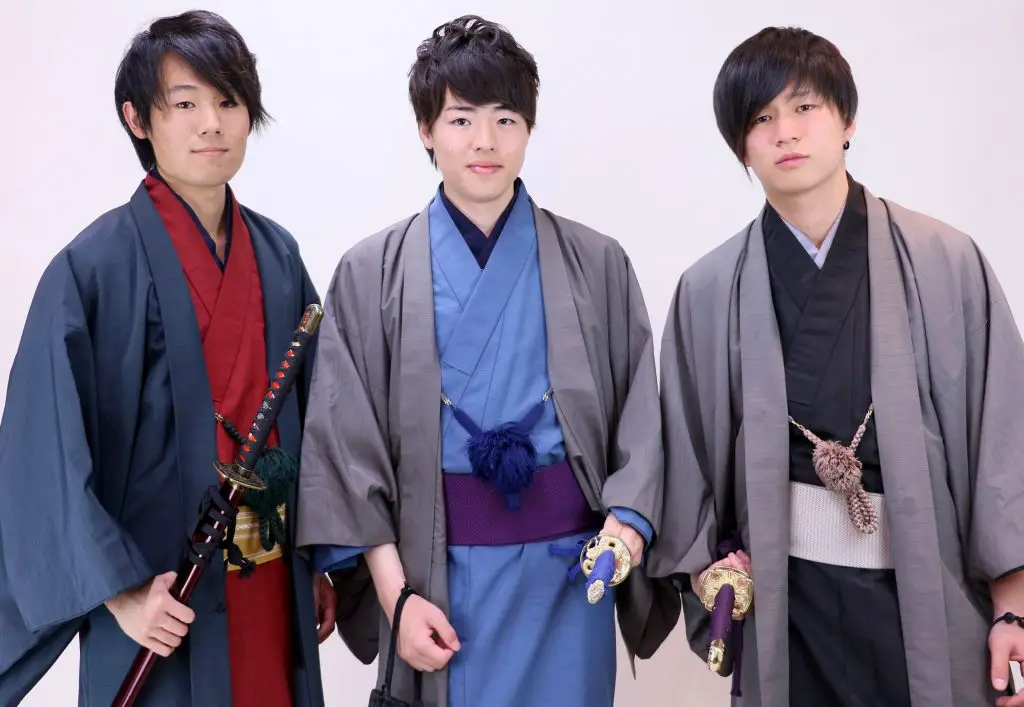
In comparison with women’s kimonos, men’s kimonos are simpler with basic colors.
2. What Are Formal Colors For Kimono?
Regarding kimono colors, some are considered more formal than others. Black, white, silver, and gold are the main colors, which will slightly elevate the attire’s formality. For example, a black kimono with the same design as a green kimono will be more formal than the green kimono.
3. How To Wear Kimono?
In Japanese, putting on a kimono is known as kitsuke. According to Junichi Nakahara (1913-1983), a Japanese fashion designer and journalist, kitsuke is as vital for kimono as design for western clothing. The way you wear your kimono completely changes the look. But don’t worry, wearing kimono is not as difficult as you would think.
Check out the videos below to learn how to wear kimono!
This video shows how to wear women’s kimono:
And this video is about how to put on men’s kimono:
4. What Are Short Kimonos Called?
Haori is a short kimono, like a jacket.
5. Kimono vs Yukata
When you see yukata or kimono, you will immediately recognize them as they are very distinct garments. But do you know the differences between them? This part will show some differences you may notice between the kimono and yukata. But first, let’s see if they have anything in common!
When it comes to wearing kimono and yukata, there is one crucial rule. The left panel must be worn over the right panel. In Japanese culture, wearing them backwards is considered exceedingly impolite as individuals who have died are wrapped in a right-over-left kimono. So, before leaving the house, double-check how you put on your kimono or yukata.
Regarding the differences between kimono vs yukata, there are several ones listed in the table below.
| Kimono | Yukata | |
| Collar | Having at least two collars (one close to the neck and one just below called a juban collar) | Having one collar as a juban collar isn’t worn below |
| Length of the sleeves | Varying according to different factors such as age and the solemnity of an event | No longer than around 50cm |
| Material | Silk | Cotton or polyester |
| Lining | Worn underneath the patterned silk layer | Never worn |
| Seasons | Worn in winter | Worn in summer |
| Occasions | For formal occasions, such as first prayer of the new year or graduation from high school | Worn in the summer months to attend matsuri of fireworks or other summer festivals |
6. Can Foreigners Wear Kimono?
Yes! Japanese people are enthusiastic about sharing their culture with the rest of the world. The kimono and yukata are among the most common gifts given to foreign visitors in Japan. Japanese language schools and other exchange facilities frequently organize kimono or yukata events for students from abroad. This shows that the Japanese desire to share their kimono with people from different cultures. It is far preferable to treat kimono with respect rather than disregard it. Because the kimono industry has declined by 90% in the last few decades, it now depends on new audiences to survive.
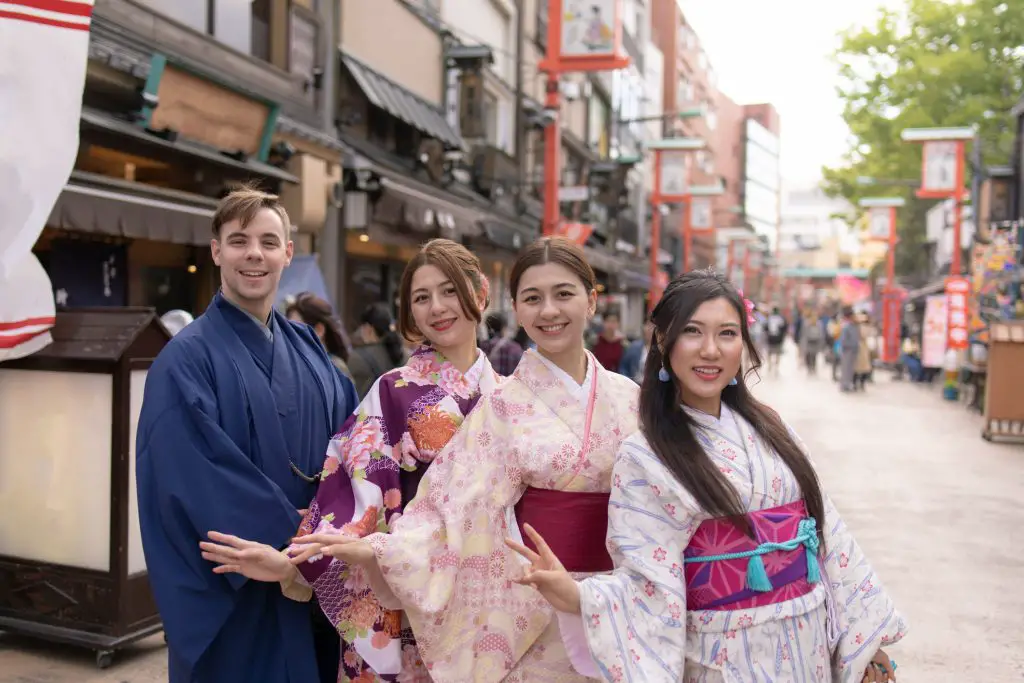
The kimono and yukata are among the most common gifts given to foreign visitors in Japan.
7. Are Kimono Uncomfortable To Wear?
Not at all! If you’re having trouble wearing your kimono, it’s possible that your ties are too tight or too loose. Of course, if you’re wearing a kimono for the first time, you may feel confined in unexpected ways, but you’ll rapidly get used to it and begin to feel comfortable and confident in it. One thing that can help is switching from regular cotton ties to stretchable elastic ties.
Conclusion
Japanese people have used kimono for hundreds of years. Today, kimono is usually worn only on important holidays and events. Women wear kimono more regularly than men, and woman kimono often have brighter colors and more eye-catching patterns. Men wear kimono primarily in weddings and tea ceremony ceremonies, and kimono for men are usually darker and pattern-free.


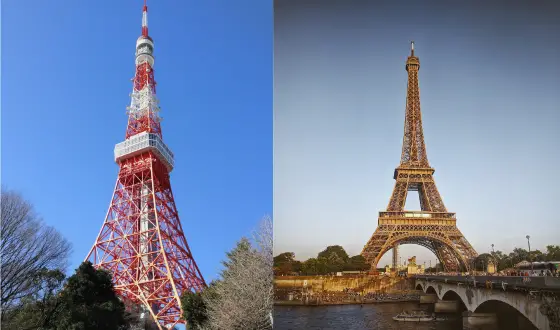
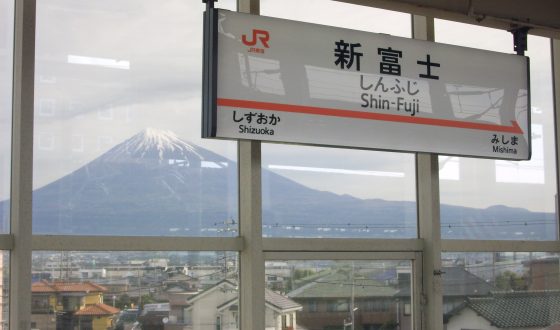
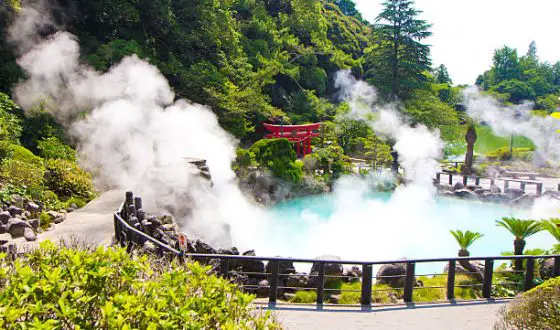





Hello, Thank you for the very interesting article. The photos for #11 and #12 are the same. What does the yukata look like?